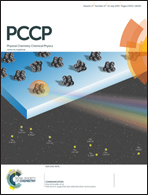The R- and S-diastereoisomeric effects on the guanidinohydantoin-induced mutations in DNA†
Abstract
Direct and indirect oxidation of guanine in DNA produces guanidinohydantoin (Gh), which is capable of inhibiting replication and inducing mutations during cellular activities. Although some biochemical studies have proposed that Gh may induce exclusively G to C mutations in DNA, other studies have predicted the occurrence of both G to C and G to T mutations. However, the exact reasons for these mutations and the dubious character of Gh in this context are not yet understood. Further, due to insufficient structural data, the electronic structure of Gh that can participate in the formation of different base pair complexes in DNA is also not known. Here, density functional theory (DFT) is used to find the most stable tautomers of Gh at the base level out of a total 112 possible tautomers and their involvement in mutagenesis is investigated by computing structures, energies and electronic properties of different base pair complexes formed between the syn- and anti-conformations of the most stable tautomer of Gh (aGh) and all the bases of DNA. It is found that aGh can coexist in R- and S-diastereoisomeric configurations. Due to the flexible guanidinium group, it can rotate about the N3–C4 bond in each of the above diastereoisomers to form two different stable conformations (aGh1 and aGh2). It is further shown that among the different base pair complexes involving aGh1, syn-aGh1:G is the most stable. This indicates that G would be easily incorporated against syn-aGh1 giving rise to G to C mutations in DNA. However, in the case of aGh2, G is the preferred base pair partner of syn-aGh2 and T is the preferred base pair partner of anti-aGh2. This implies that in addition to G to C mutations, the occurrence of aGh2 in DNA may also induce G to A mutations. Further, due to similarities between base pairing patterns and binding energies of syn-aGh1:A and syn-aGh2:A complexes with those of the T:A complex, DNA polymerases may mistakenly insert A opposite aGh1 or aGh2 by misrecognizing the latter as T. This may ultimately induce G to T mutations in DNA. However, as the constraints imposed by the DNA backbones and stacking interactions were not considered here, the possibilities of aGh2:T and aGh2:A base pairs need to be investigated experimentally. It is further found that the mutagenic character of aGh in the R- and S-diastereoisomeric forms is similar.


 Please wait while we load your content...
Please wait while we load your content...